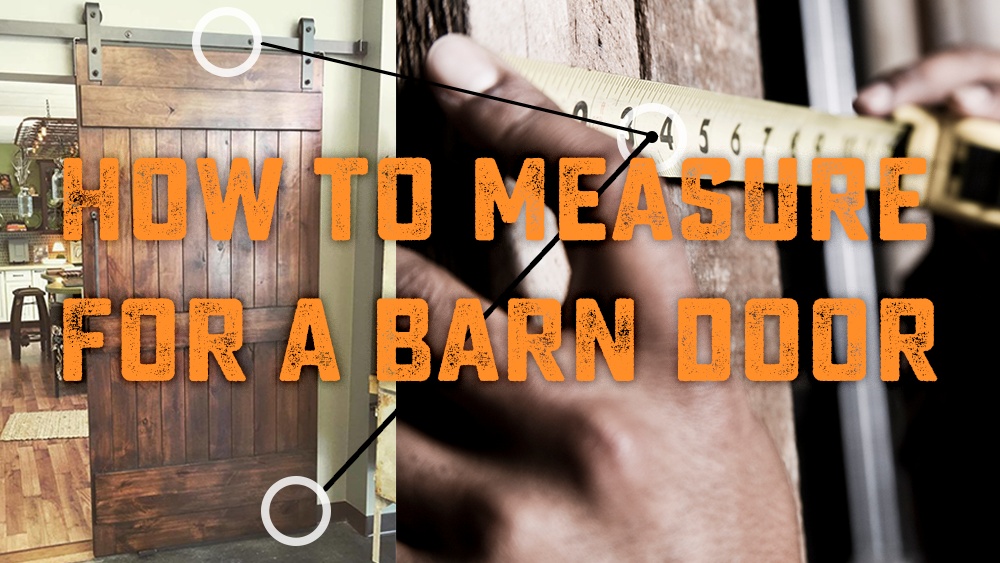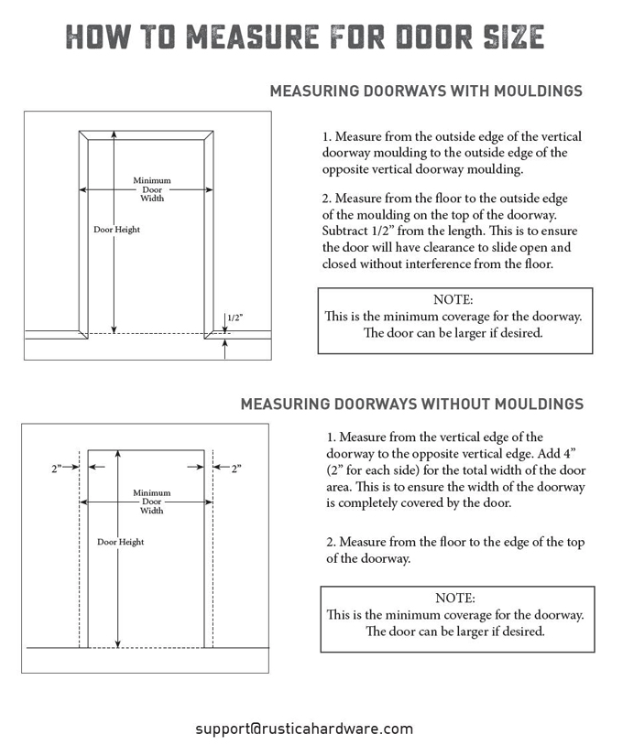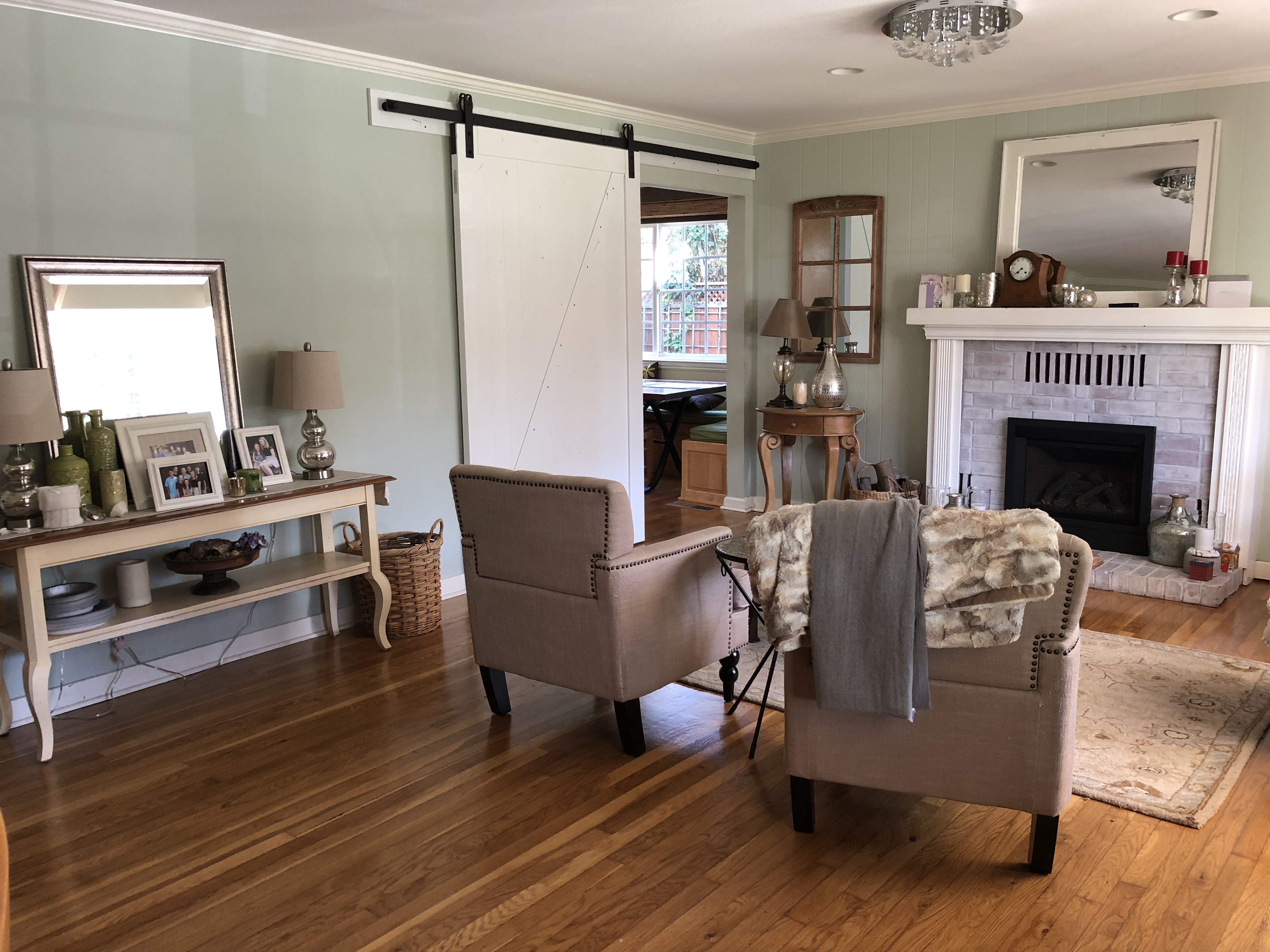1.800.891.8312
800-891-8312
FREE SHIPPING*
Free Shipping Details
Most orders over $500 qualify. Free shipping applies to Barn Door Hardware, Barn Doors, and Pocket Doors over $500.
Note: Front doors, interior doors, shower doors, any oversized door (wider than 3ft and taller than 7ft) and any special order doors have shipping costs calculated at checkout. Some barn door hardware track lengths do not qualify for free shipping.

How to Measure for a Barn Door
Thursday, July 19th, 2018
Author: Kate Allen - Rustica Founder and CEO
Share
How to Measure for a Barn Door
DIY barn door projects are super popular right now and (even better) they’re easier to install than you think! But before you start comparing which style of door you want or deciding on a railing system you like, you’ll need to take a step back and do some math.How to Measure for a Barn Door
- Barn Door Opening Measurements
- Subtracting Trim
- Adding Trim
- Make Allowance for Door Hardware
- Know Your Clearance

That’s right, you’re going to need to know exactly how much door space your working with: that includes the width and length of the door entry… and the distance between the top of the door and the ceiling. After all, the last thing you want is a railing system that’s too big because you just guesstimated the size.
How To Measure For a Sliding Barn Door & Track?
To help you get started, here’s a quick summary of measurements you’ll need to take before installing your door and track.1. Barn Door Opening Measurements
While the style of barn door you choose will come down to your personal preference, you will need to be aware of barn door vs opening dimensions when making your choice. Your door’s width should be 2 to 3 inches wider than the door opening and 1 inch higher than the dimensions of your opening. The determining factor in how high or how wide you want to go is just how much you want your sliding door to overlap with the opening.Quick rule of thumb: If your sliding door is in a room where you may want some extra privacy (like a bathroom or guest room), you’ll want to create even more of an overlap to prevent noise leakage and peripheral gaps.
2. Subtracting Trim
Your next step is to calculate the width of the door’s opening, starting from inside the door jamb on one side, all the way to the inside edge of the other. Repeat this step to find the height, measuring from the edge of the door header all the way down to the top of your flooring. You don’t want to measure past the flooring, otherwise your door won’t slide shut smoothly.Once you calculate those dimensions, plus whatever amount for overlap you want, you’ve got the dimensions you need for your door opening.

3. Adding Trim
This step is similar to the way you would measure (above) your door without trim. However, instead of measuring from inside edge to inside edge, you’ll want to add the trim dimensions to both the length and the width of your door measurements, plus your desired amount for privacy overlap.4. Make Allowances For Door Hardware
Once you’ve recorded the measurements for your door opening, you’re ready to measure for your barn door hardware. Always remember that your barn door railing system should be at least double the width of your door frame -- possibly longer if you have an odd-shaped door. For instance, if you have a doorway that’s 35”, you’ll want a track that’s at least 70” -- although a safe 6ft. (72”) would probably be even better.
5. Know Your Clearance
Finally, measure the distance from the top of the door frame or entrance to the ceiling. This is a vital step for successfully measuring for a barn door track because you’ll be a bit more limited if you’re installing your door on an entryway that has low ceilings. Knowing this clearance measurement will help you find a railing system that is sure to fit that space without a hiccup.Note:Depending on how you plan to install your door (particularly if you’re hanging it by yourself), you may also want to consider measuring the distance between the studs on the wall where you want to hang your door. Some companies will pre-drill your metal railing system to fit these stud measurements to save you a step from having to do it yourself.
Frequently Asked Questions About Measuring for a Sliding Barn Door
It’s normal for homeowners, designers, and DIYers alike to have questions when researching how to measure for a sliding barn door. The below topics address the most common concerns, teaching you what you need to know in order to assemble your hardware kit and begin your DIY barn door installation. It’s also helpful to review our Parts of a Door article to gain a better understanding of the necessary vocabulary for measuring and installing a barn door track.How much bigger should a barn door be than the opening?
Since barns doors are sold in different dimensions, there is no one correct answer for the difference in measurements between a sliding barn door and its door opening. However, there is a general rule! At a minimum, you’ll want to allow for a one-inch overlap on either side.So, if your door opening is 36 inches wide, you’ll want to purchase a barn door that is 38 inches wide, from the left to right outside edge, for your barn door kit. This measurement is perfect for a closet, pantry, or living space door that doesn’t require a lot of privacy.
If you plan on installing a sliding door in an entryway for a bathroom, bedroom, or office area, you may want to increase your door width by another inch or two on either side. A wider door allows less light and sound to filter through the doorway and creates more privacy between rooms.
A pocket door is an exception to this rule as the panel does not rest on top of wall space. Instead, it slides into a space in the wall, mostly disappearing when open. For this reason, pocket doors are generally around the same size as the door opening, similar to hinged doors. Still, homeowners should keep in mind that they need to have viable wall space (the size of the panel) in which to create the pocket hole for the door.
The one-inch (or more) rule applies to door height as well. You’ll want to measure from the floor to the top edge of the door frame. Then, add one inch total to that number. You may consider adding more if you want to create a dramatic statement with your door or if you want more privacy. Just be cautious and take into consideration the necessary measurements for your door track.
For a standard track system, you’ll want to leave at least six inches above your door opening, which means five inches above your door panel if you’ve chosen to add a total of one inch. There are low clearance options that only require four inches above the frame (three above the standard panel) or ceiling mount barn door hardware, which eliminates the worry of header space and allows homeowners to purchase larger-than-usual sliding panels. Any of these options can be included in your hardware kit.
You will most likely be able to find the measurement that works best for your space and design goals, especially when you purchase a custom barn door from Rustica.
How thick and wide is the barn door hardware track?
There is also a rule of thumb when choosing the width of your barn door track. In order to ensure that your door completely clears the doorway when open, you’ll want to purchase a metal track that is at least double the width of your door. If you want to slide your single panel door in both directions, you’ll want to triple your panel’s width when choosing the track’s dimensions. Bi-parting and bypassing doors will naturally go in either direction, so the track should be double the width of both doors together.The thickness of a barn door hardware track will likewise vary based on the thickness of the door. Regular door thickness for interior doors is 1 ⅜ inch, and standard barn door hardware is 1 ¾ inch, easily accommodating the standard panel’s dimensions.
If you’ve purchased a thicker door for privacy or security reasons, or if you have trim (also known as casing) or a baseboard that interferes with the slide of your panel when using a standard track, you’ll want to purchase spacers. A spacer increases the space between the track and the wall to accommodate for a greater thickness. Rustica’s spacers are adjustable and can be purchased in sizes between 1 ¼ and 2 ⅕ inches. Our heavy-duty spacers are between 2 ¾ and 3 ¾. These will accommodate a larger door thickness.
Can you hang a barn door without a header?
It is possible to hang a door without a wood header, though it isn’t an ideal choice. Headers are important because they distribute the pull of the door’s weight across more wall beams. Without a header, your door will rely on the strength of just a few. If you purchase a larger door or a door made from heavier material, you won’t have the option of not using a header.You’ll need to use a stud finder to locate your beams and then install a header that is three inches wider than your rough opening. Then, you’ll attach your track system to the header using carriage bolts. If you’ve chosen a lighter panel option or if you don’t have space for a header, you can purchase low clearance barn door hardware, but you’ll still need to locate your wall stud (or studs) when mounting the track.
A helpful tip for this step is to always make a pre-drilled hole in the wall and/or header for your screw so that you can line up your track to the beams or your header to the beams without error. Still, if you do make a mistake in your header or beam, making an accidental or incorrect hole, you can always use wood filler to cover up cosmetics or repair small structural damage.
How far does a barn door stick out from the wall?
With a standard track system, a barn door will stick out 1 ¾ inch. However, sometimes this isn’t enough. This is where spacers are helpful in allowing the door to stick out up to 3 ¾ inches to accommodate for baseboard and trim thickness.Once you figure out the thickness you’ll need, you can go ahead and add a floor guide, also known as a door guide if desired, and consider the type of lock options that will work for your door type and size.
Order a Rustica Barn Door Hardware Kit Today!
In addition to including the ideal track system, homeowners can add beautiful, artisan-crafted barn door panels to their barn door kits, making installation even simpler.You won’t need to worry about a table saw or miter saw, instead you’ll only need a trusty tape measure to gather your dimensions and tell us exactly what your door and track design requires.
Now that you know exactly how to measure for a barn door rail, it’s time to get to work on assembling a Rustica barn door hardware kit!


Rustica Shop & HQ 1060 Spring Creek PlaceSpringville Utah 84663Customer Service & Sales(800)-891-8312

Hitching Post
Event Venue
1520 N Main Street
Springville UT 84663
PRODUCTS
FEATURES
COMPANY
BUSINESS



